Microstratigraphic Records as Tools for the Detection of Climatic Changes in Tana di Badalucco Cave (Liguria, NW Italy)
Abstract
:1. Introduction
1.1. Archaeological Context
1.2. Environmental Context
2. Materials and Methods
2.1. Sampling
2.2. Micromorphology
3. Results
3.1. First Part of the Cave (Sample: MTB1)
3.2. In the Middle of the Cave (the M Series, M1–M5)
3.3. Inner Part (WK1, WK2)
4. Discussion
4.1. First Part of the Cave (Sample: MTB1)
4.2. In the Middle of the Cave (the M Series, M1–M5)
4.3. Inner Part (WK1, WK2)
4.4. Tana di Badalucco Cave Deposits and Their Paleoclimatic Implications
5. Conclusions
Author Contributions
Acknowledgments
Conflicts of Interest
References
- Mercuri, A.M.; Allevato, E.; Arobba, D.; Bandini Mazzanti, M.; Bosi, G.; Caramiello, R.; Castiglioni, E.; Carra, M.L.; Celant, A.; Costantini, L.; et al. Pollen and macroremains from Holocene archaeological sites: A dataset for the understanding of the bio-cultural diversity of the Italian landscape. Rev. Palaeobot. Palynol. 2015, 218, 250–266. [Google Scholar] [CrossRef] [Green Version]
- Barham, A.J.; Macphail, R.I. (Eds.) Archaeological Sediments and Soils: Analysis, Interpretation and Management; Routledge: New York, NY, USA, 2016. [Google Scholar]
- Branch, N.P.; Black, S.; Maggi, R.; Marini, N.A.F. The Neolithisation of Liguria (NW Italy): An environmental archaeological and palaeoenvironmental perspective. Environ. Archaeol. 2014, 19, 196–213. [Google Scholar] [CrossRef]
- Molinari, I.; Montinari, G.; Rossi, G. Grotta Torello/Tuvetto o Tana di Badalucco, Pigna (IM)-Un Contesto Disperso; Archeologia in Liguria, Volume V; Conventi, M., Del Lucchese, A., Gardini, A., Eds.; SAGEP: Genova, Italy, 2012. [Google Scholar]
- Calandri, G.; Crippa, C.; Ramella, L. Lo Sgarbu di Barraico in val Nervia (Provincia di Imperia). Riviera dei Fiori. Rivista della Camera di Commercio di Imperia 1979, 12, 3–13. [Google Scholar]
- Hosmer Zambelli, F. La Tana di Badalucco nella Liguria Occidentale. Le Grotte d’Italia 1934, XII, 1–11. [Google Scholar]
- Ricci, M. Pigna nella preistoria. In Pigna e il suo Territorio; Cartoguide De Agostini: Roma, Italy, 1988; p. 21. [Google Scholar]
- Sandgathe, D.M.; Dibble, H.L.; Goldberg, P.; McPherron, S.P. The Roc de Marsal Neandertal child: A reassessment of its status as a deliberate burial. J. Hum. Evol. 2011, 61, 243–253. [Google Scholar] [CrossRef] [PubMed]
- Bianchi, N.; Rellini, I.; Traverso, A.; Pigna, A. Grotta Giacheira e Tana di Badalucco: La ripresa delle ricerche. Archeol. Liguria 2015, V, 128–130. [Google Scholar]
- Courty, M.-A.; Goldberg, P.; Macphail, R. Soils and Micromorphology in Archaeology; Cambridge University Press: Cambridge, UK, 1990; ISBN 978-0-521-32419-9. [Google Scholar]
- Stoops, G.; Marcelino, V.; Mees, F. Interpretation of Micromorphological Features of Soils and Regoliths; Elsevier: Amsterdam, The Netherlands, 2010; ISBN 978-0-08-093230-9. [Google Scholar]
- Kubiena, W.L. Micropedology; Collegiate Press, Inc.: Ames, IA, USA, 1938. [Google Scholar]
- Rellini, I.; Trombino, L.; Carbone, C.; Firpo, M. Petroplinthite formation in a pedosedimentary sequence along a northern Mediterranean coast: From micromorphology to landscape evolution. J. Soils Sediments 2015, 15, 1311–1328. [Google Scholar] [CrossRef]
- Vogel, S.; Märker, M.; Rellini, I.; Hoelzmann, P.; Wulf, S.; Robinson, M.; Steinhübel, L.; Di Maio, G.; Imperatore, C.; Kastenmeier, P.; et al. From a stratigraphic sequence to a landscape evolution model: Late Pleistocene and Holocene volcanism, soil formation and land use in the shade of Mount Vesuvius (Italy). Quat. Int. 2016, 394, 155–179. [Google Scholar] [CrossRef]
- Nicosia, C.; Stoops, G. Archaeological Soil and Sediment Micromorphology; John Wiley & Sons: Hoboken, NJ, USA, 2017; ISBN 978-1-118-94105-8. [Google Scholar]
- Ismail-Meyer, K.; Rentzel, P.; Wiemann, P. Neolithic Lakeshore Settlements in Switzerland: New Insights on Site Formation Processes from Micromorphology. Geoarchaeology 2013, 28, 317–339. [Google Scholar] [CrossRef]
- Macphail, R.I.; Goldberg, P. Applied Soils and Micromorphology in Archaeology; Cambridge University Press: Cambridge, UK, 2017; ISBN 978-1-108-50858-2. [Google Scholar]
- Karkanas, P.; Goldberg, P. 6.23 Micromorphology of Cave Sediments. In Treatise on Geomorphology; Elsevier: Amsterdam, The Netherlands, 2013; ISBN 978-0-08-088522-3. [Google Scholar]
- Goldberg, P.; Schiegl, S.; Meligne, K.; Dayton, C.; Conard, N.J. Micromorphology and Site Formation at Hohle Fels Cave, Swabian Jura, Germany. Available online: https://www.eg-quaternary-sci-j.net/53/1/2003/egqsj-53-1-2003.pdf (accessed on 6 May 2019).
- Courty, M.-A.; Vallverdu, J. The microstratigraphic record of abrupt climate changes in cave sediments of the Western Mediterranean. Geoarchaeology 2001, 16, 467–499. [Google Scholar] [CrossRef]
- Woodward, J.C.; Goldberg, P. The sedimentary records in Mediterranean rockshelters and caves: Archives of environmental change. Geoarchaeology 2001, 16, 327–354. [Google Scholar] [CrossRef]
- Rellini, I.; Firpo, M.; Martino, G.; Riel-Salvatore, J.; Maggi, R. Climate and environmental changes recognized by micromorphology in Paleolithic deposits at Arene Candide (Liguria, Italy). Quat. Int. 2013, 315, 42–55. [Google Scholar] [CrossRef]
- Lowe, J.J.; Walker, M.J.C. Reconstructing Quaternary Environments; Routledge: Abingdon-on-Thames, UK, 2014; ISBN 978-1-317-75371-1. [Google Scholar]
- Issel, A. Liguria: Geologica e Preistorica; Donath, A., Ed.; A. Forni: Genova, Italy, 1892. [Google Scholar]
- Issel, A. Liguria Preistorica. Donath, A., Ed.; Società ligure di Storia Patria: Genova, Italy, 1908. [Google Scholar]
- Chiarenza, N. 16 Mountains and shore: sites and communication routes of Copper Age western Liguria. In Hidden Landscapes of Mediterranean Europe - Cultural and Methodological Biases in Pre-and Protohistoric Landscape Studies 133; BAR International Series: Siena, Italy, 2011. [Google Scholar]
- Costantini, E.A.C.; Fantappié, M.; L’Abate, G. Climate and Pedoclimate of Italy. In The Soils of Italy; Costantini, E.A.C., Dazzi, C., Eds.; World Soils Book Series; Springer Netherlands: Dordrecht, The Netherlands, 2013; pp. 19–37. ISBN 978-94-007-5642-7. [Google Scholar]
- Calandri, G.; Camprendon, R. Geologia e carsismo dell’Alta Val Nervia e Argentina (Liguria occidentale): Guida escursione; Comune di Imperia. Assessorato alle attività culturali; Gruppo speleologico imperiese C.A.I.: Imperia, Italy, 1982. [Google Scholar]
- Dallagiovanna, G.; Fanucci, F.; Pellegrini, L.; Seno, S.; Bonini, L.; Decarlis, A.; Maino, M.; Morelli, D.; Toscani, G. Carta Geologica alla scala 1:25,000 Foglio 257 “Dolceacqua” e Foglio 270 “Ventimiglia” con note illustrative. CARG 2012, 257, 1–76. [Google Scholar]
- Miller, C.; Conard, N.; Goldberg, P.; Berna, F. Dumping, Sweeping and Trampling: Experimental Micromorphological Analysis of Anthropogenically Modified Combustion Features. Faculty of Science, Medicine and Health-Papers: Part A. 2010. Available online: https://ro.uow.edu.au/cgi/viewcontent.cgi?referer=https://www.google.com.hk/&httpsredir=1&article=4103&context=smhpapers (accessed on 6 May 2019).
- Goldberg, P.; Sherwood, S.C. Deciphering human prehistory through the geoarcheological study of cave sediments. Evol. Anthropol. Issues News Rev. 2006, 15, 20–36. [Google Scholar] [CrossRef]
- Benyarku, C.A.; Stoops, G. Guidelines for Preparation of Rock and Soil Thin Sections and Polished Sections; Departament de Medi Ambient i Ciències del Sòl, Universitat de Lleida: Lleida, Spain, 2005. [Google Scholar]
- Stoops, G. Guidelines for Analysis and Description of Soil and Regolith Thin Sections; Soil Science Society of America: Madison, WI, USA, 2003. [Google Scholar]
- Bullock, P. Handbook for Soil Thin Section Description; Waine Research: Wolverhampton, UK, 1985. [Google Scholar]
- FitzPatrick, E.A. Micromorphology of Soils; Springer Science & Business Media: Amsterdam, The Netherlands, 2012; ISBN 978-94-009-5544-8. [Google Scholar]
- Brewer, R. Fabric and Mineral Analysis of Soils; Wiley: Oxford, UK, 1964. [Google Scholar]
- Rodríguez-Martínez, M.; Heim, C.; Quéric, N.-V.; Reitner, J. Frutexites. In Encyclopedia of Geobiology; Reitner, J., Thiel, V., Eds.; Springer: Dordrecht, The Netherlands, 2011; pp. 396–401. ISBN 978-1-4020-9211-4. [Google Scholar]
- Karkanas, P.; Goldberg, P. Reconstructing Archaeological Sites: Understanding the Geoarchaeological Matrix; John Wiley & Sons: Hoboken, NJ, USA, 2018; ISBN 978-1-119-01643-4. [Google Scholar]
- Karkanas, P.; Goldberg, P. Cave Settings. In Encyclopedia of Geoarchaeology; Gilbert, A.S., Ed.; Springer: Dordrecht, The Netherlands, 2017; pp. 108–118. ISBN 978-1-4020-4409-0. [Google Scholar]
- Ricci, M. Grotte de Badalucco. In Les Premiers Peuplements de la Còte d’Azur et de la Ligurie; De Lumley, H., De Lumley M., A., Eds.; Melis: Nice, France, 2011; Volume Tome I, pp. 92–93. ISBN 2-35210-068-2. [Google Scholar]
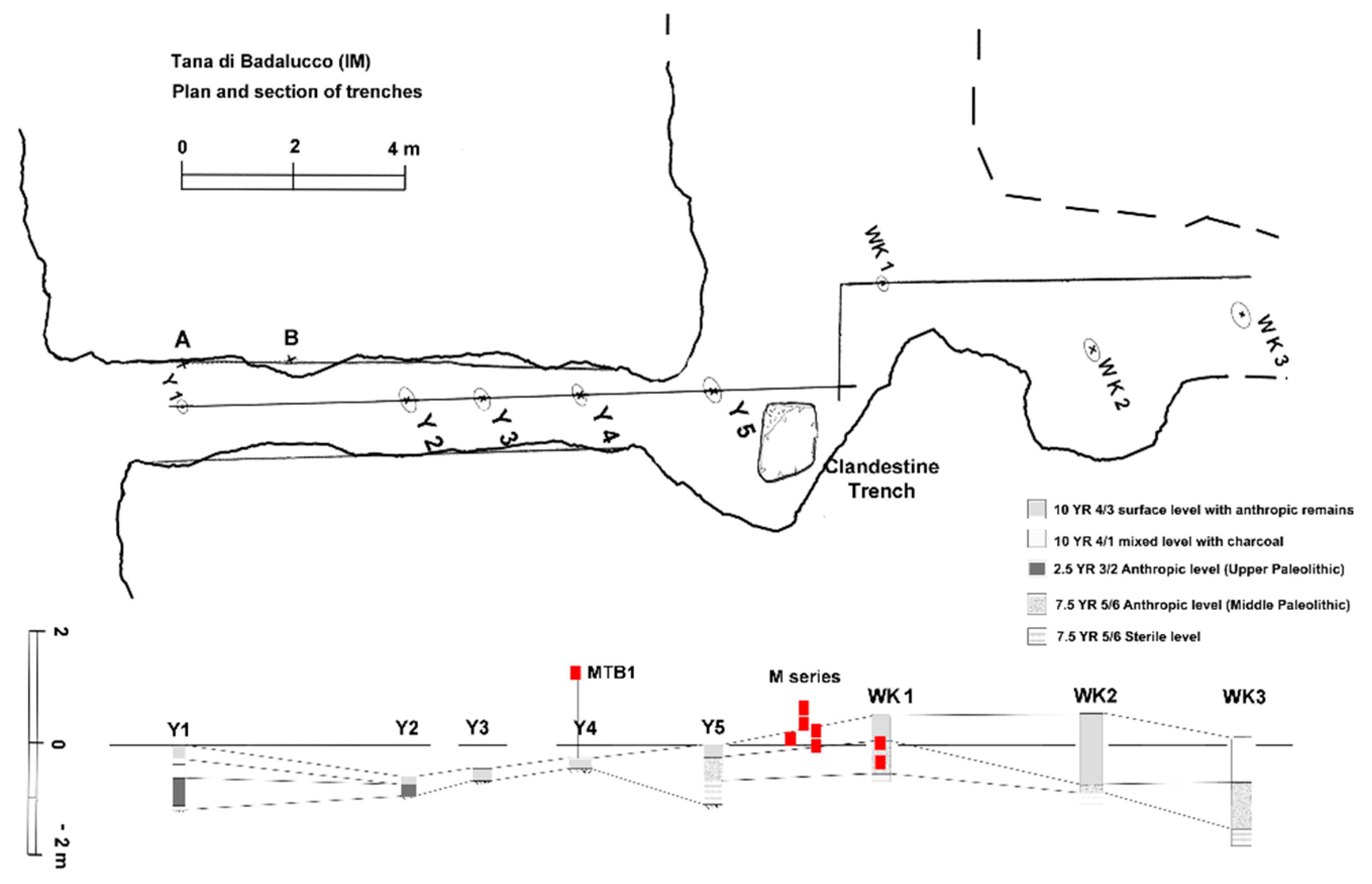
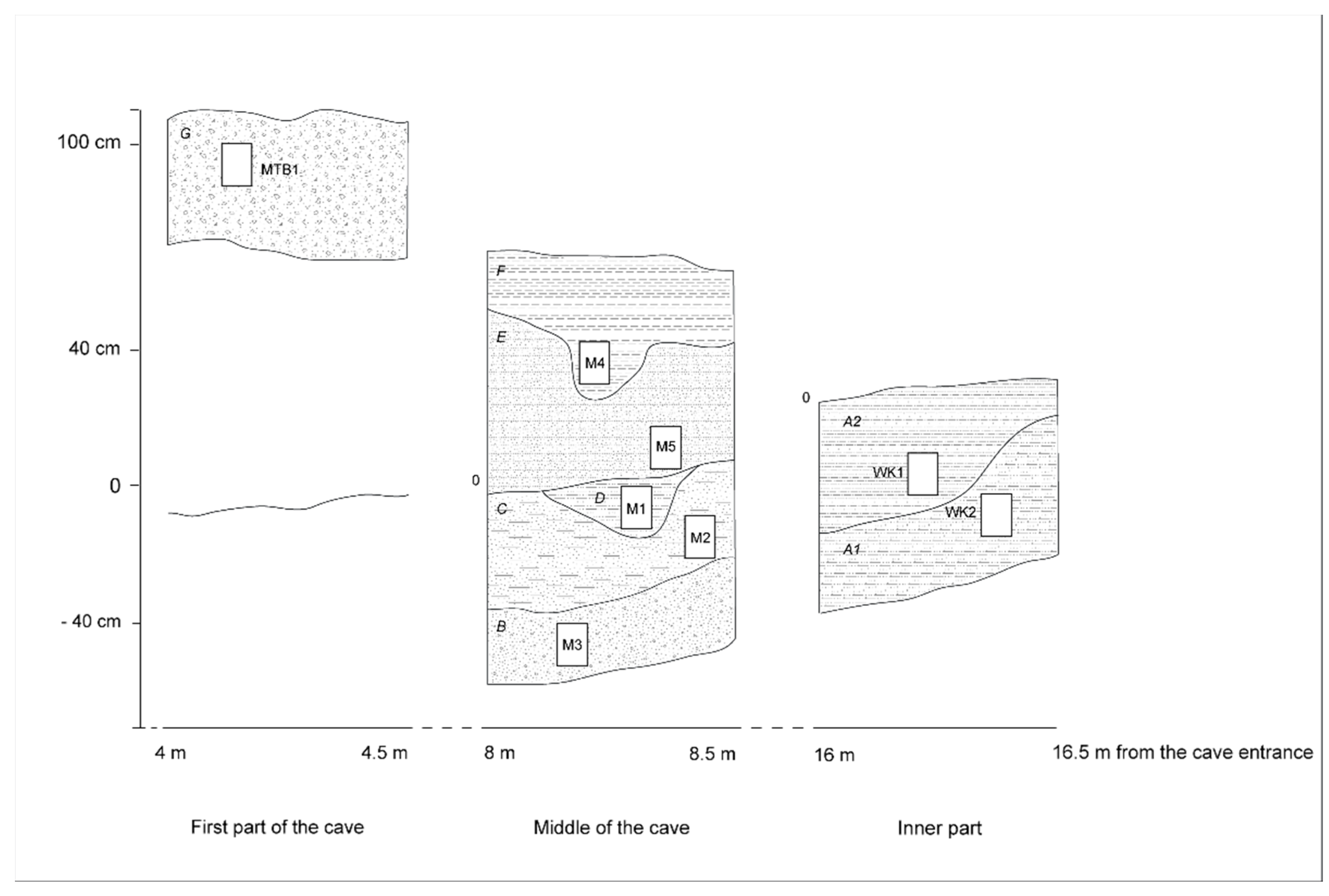
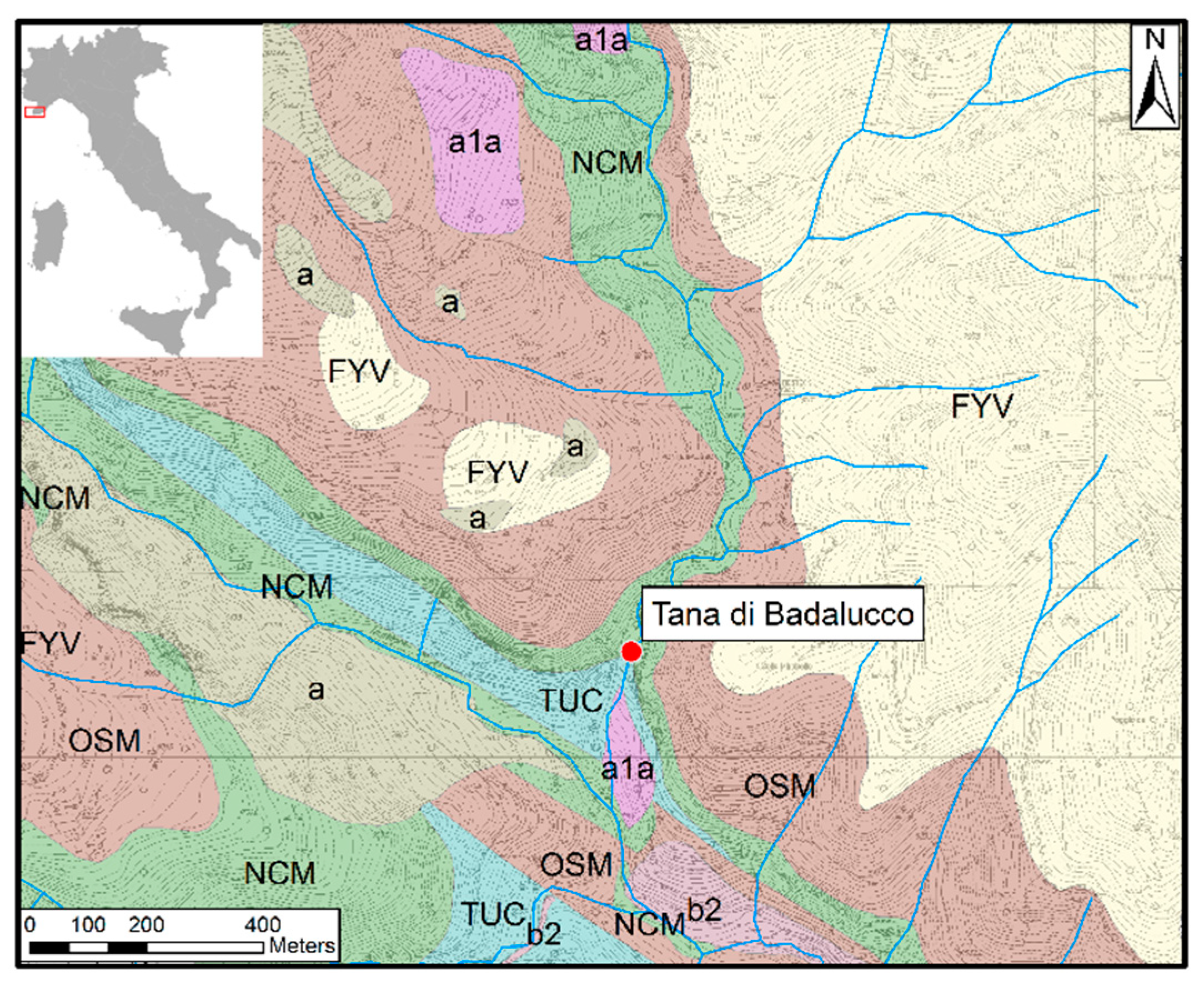
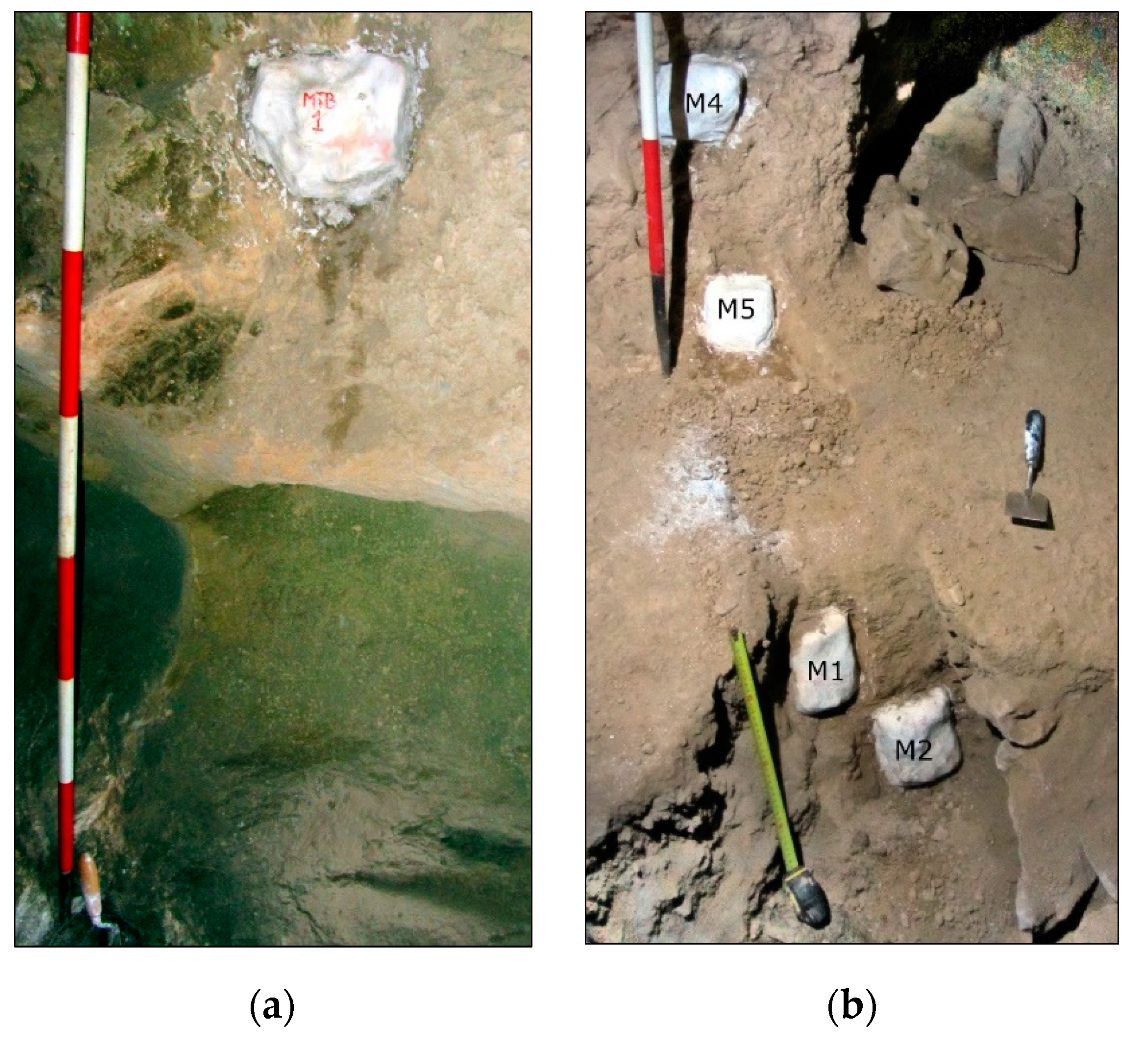
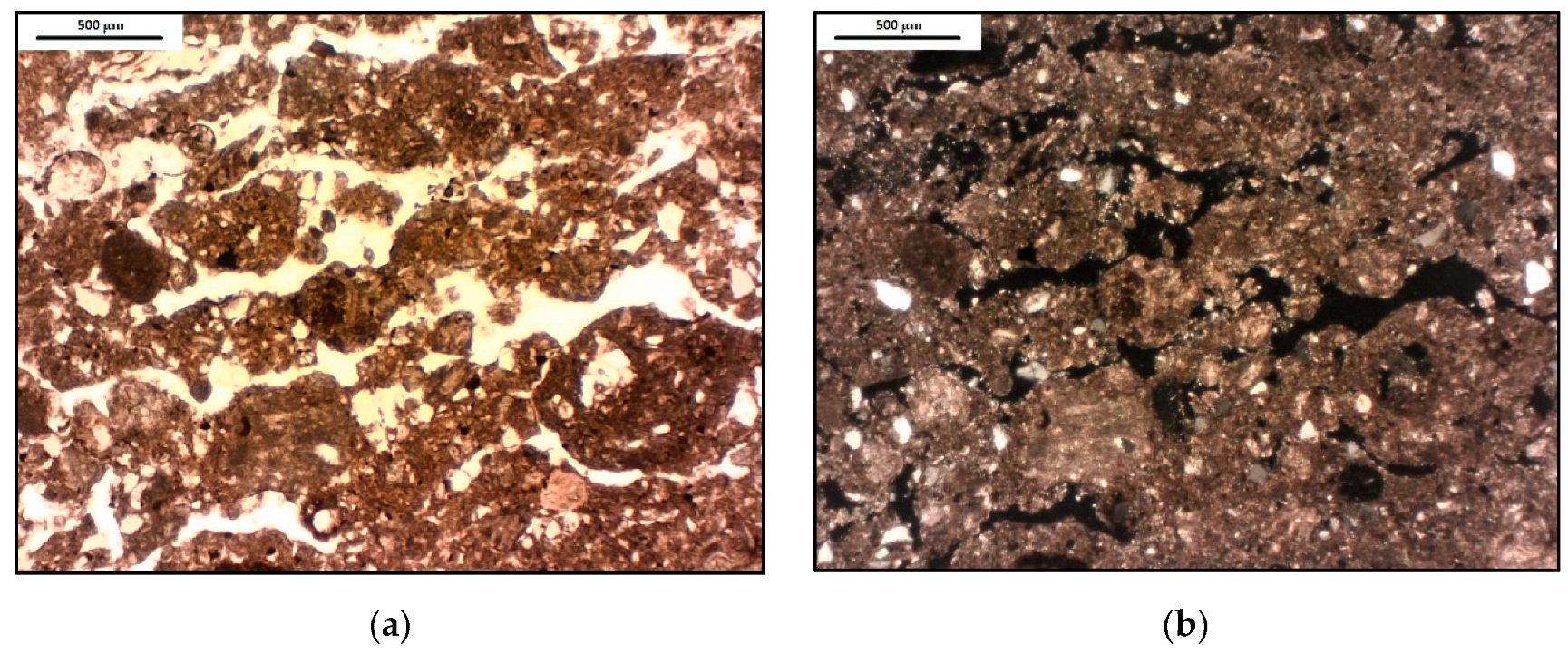
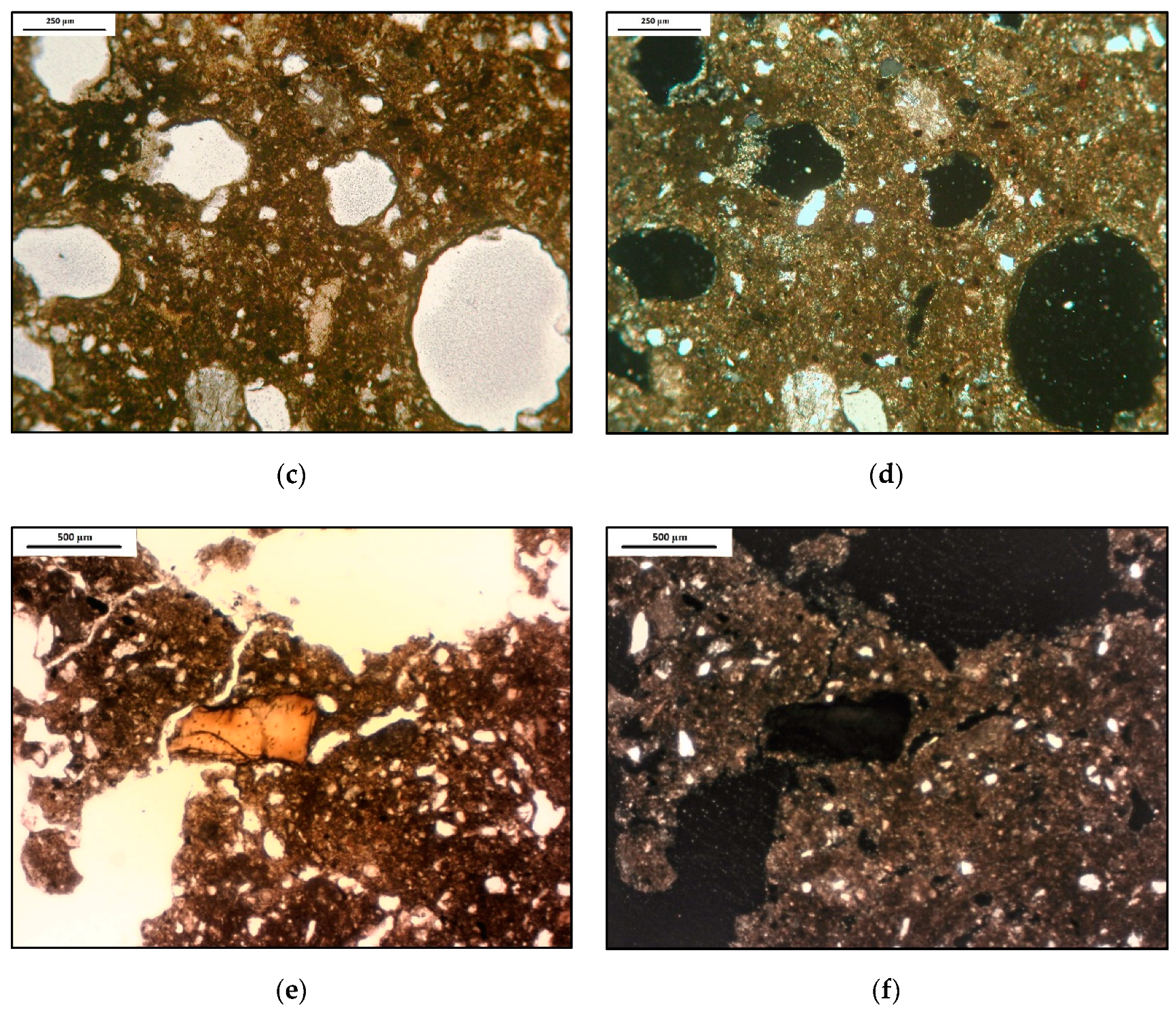
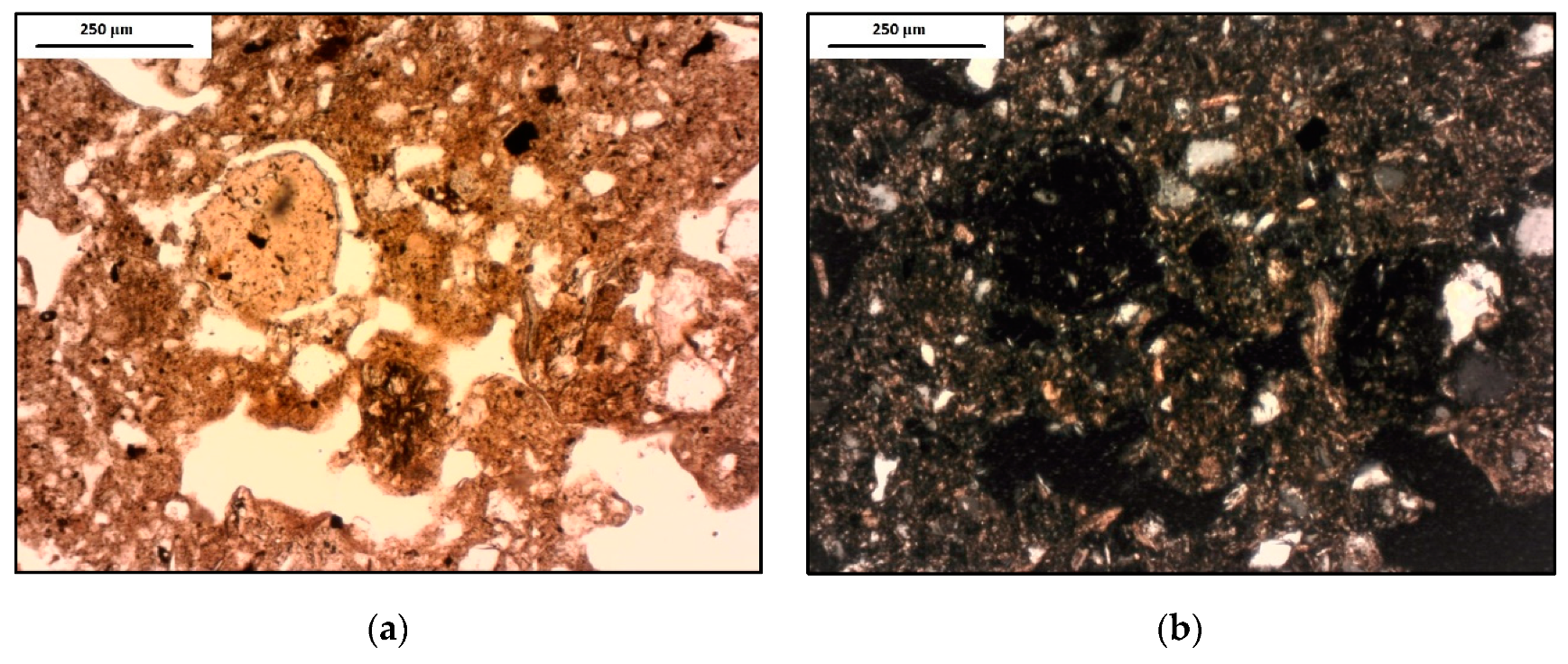
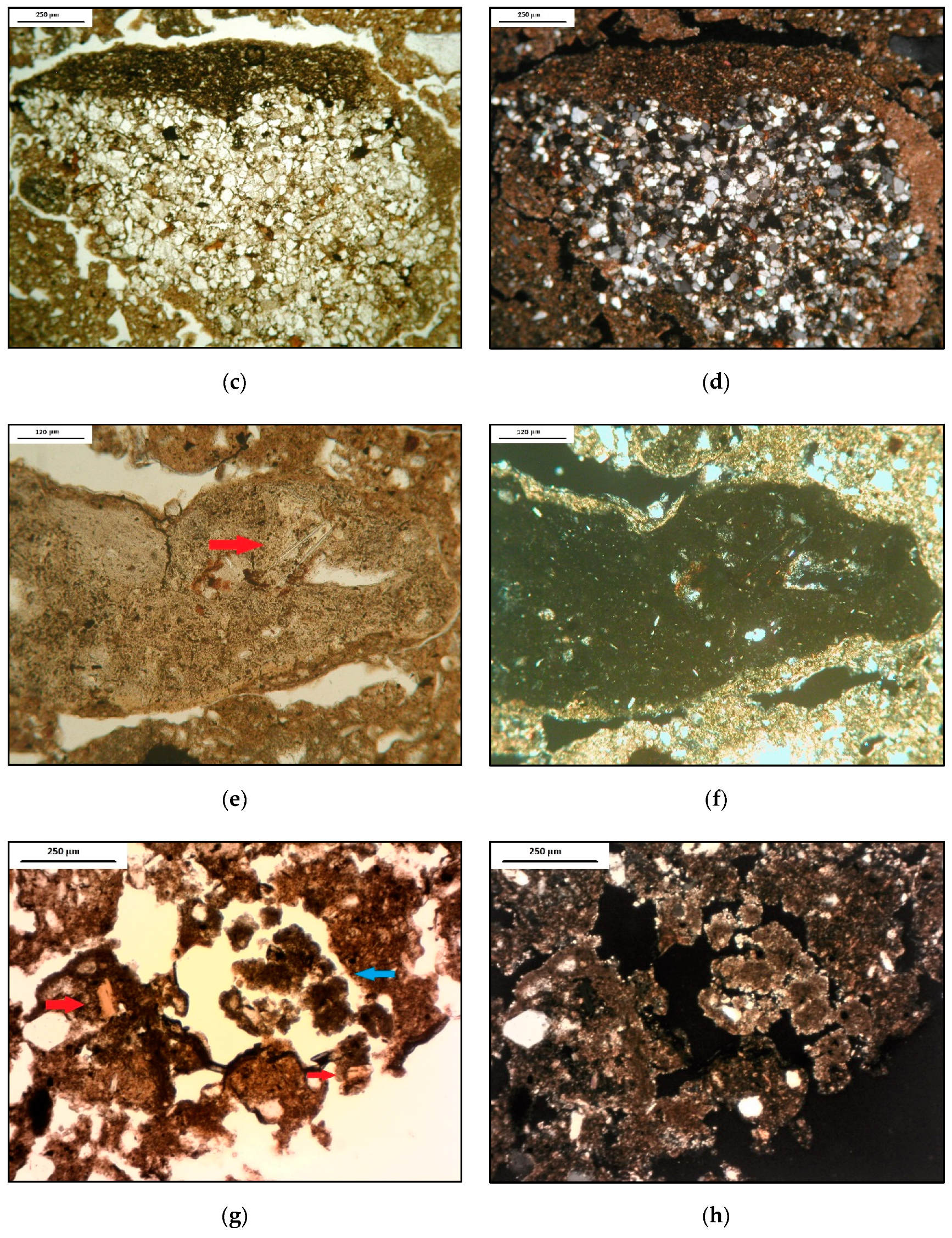
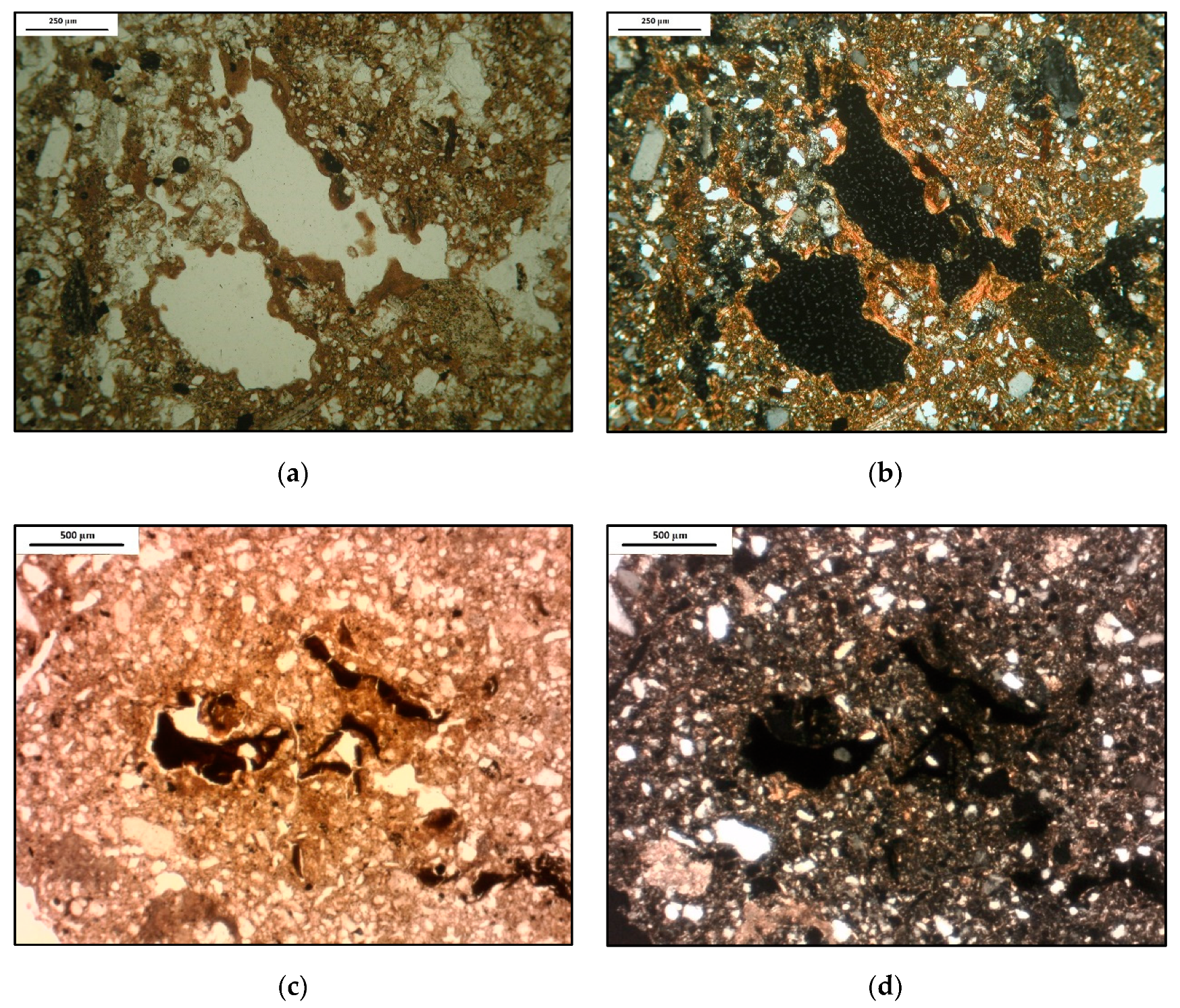
| Portion of the Cave | Sample | Thickness | Main Features | Inferences |
|---|---|---|---|---|
| First part of the cave | MTB1 | +100 cm | Subangular blocky-platy microstructure, burnt and unburnt bones, charcoal. | Cold climate stage. Human occupation. |
| Middle | M4 | +30 cm | Burnt bone fragments, charcoal, ashes. | Signs of combustion and strong weathering. |
| - | M5 | +5 cm | Reworked ashes and charcoal. | A truncated sequence of different occupied surfaces. |
| - | - | - | Angular quartz grains and calcitic features in contact with clay pedofeatures and Fe hypocoatings. | Short arid interval replaced by humid conditions. |
| - | M1 | −10 cm | Crumbs, vughs, and unburnt bones. | Probable use as a den for the cold period. |
| - | M2 | −20 cm | Crumbs, high alteration, clay pedofeatures | Freeze and thaw, water passage. |
| - | M3 | −40 cm | Platy microstructure, accumulation of coarse material in correspondence to planar voids. | Cold climate stage. Animal occupants. |
| Inner part | WK1 | −20 cm | Prior loess deposits. High state of alteration, unburnt bones, rare Mn traces. | Arid situation replaced by humid conditions, flood events, rise of the water table. |
| - | WK2 | −30 cm | Prior loess deposits. More clay and iron pedofeatures. | As above, but with a more prolonged stagnation. |
© 2019 by the authors. Licensee MDPI, Basel, Switzerland. This article is an open access article distributed under the terms and conditions of the Creative Commons Attribution (CC BY) license (http://creativecommons.org/licenses/by/4.0/).
Share and Cite
Sessa, E.; Rellini, I.; Traverso, A.; Molinari, I.; Montinari, G.; Rossi, G.; Firpo, M. Microstratigraphic Records as Tools for the Detection of Climatic Changes in Tana di Badalucco Cave (Liguria, NW Italy). Geosciences 2019, 9, 276. https://doi.org/10.3390/geosciences9060276
Sessa E, Rellini I, Traverso A, Molinari I, Montinari G, Rossi G, Firpo M. Microstratigraphic Records as Tools for the Detection of Climatic Changes in Tana di Badalucco Cave (Liguria, NW Italy). Geosciences. 2019; 9(6):276. https://doi.org/10.3390/geosciences9060276
Chicago/Turabian StyleSessa, Eleonora, Ivano Rellini, Antonella Traverso, Irene Molinari, Giulio Montinari, Guido Rossi, and Marco Firpo. 2019. "Microstratigraphic Records as Tools for the Detection of Climatic Changes in Tana di Badalucco Cave (Liguria, NW Italy)" Geosciences 9, no. 6: 276. https://doi.org/10.3390/geosciences9060276
APA StyleSessa, E., Rellini, I., Traverso, A., Molinari, I., Montinari, G., Rossi, G., & Firpo, M. (2019). Microstratigraphic Records as Tools for the Detection of Climatic Changes in Tana di Badalucco Cave (Liguria, NW Italy). Geosciences, 9(6), 276. https://doi.org/10.3390/geosciences9060276





